|
Kama Sutra
For those who need a little more visual inspiration, for whatever purpose, the wonders of modern technology also offer the Kama Sutra on videotape and in computer animated format on the Web. For ultra "soft porn" types, (i.e. those who like to pretend they're not kinky)who still need visual cues to get it on upside down and backside front, there is always the Kama Sutra of Pooh as well as assorted online versions charmingly illustrated with artists mannequins or teddy bears. Even with or perhaps because of—illustrations, few modern readers have fully understood that the Kama Sutra was intended to be much more than Hindu pornography. In actual fact, it was offered as a treatise on the science of sexuality. Which explains its sometimes pedantic approach to sex —documenting every type of kiss, embrace, combination of differently sized sexual parts, and the relevant cause or effect or remedy for each of these. It even explains whom to have affairs with, what to do when the gay shampoo boy feels up your cock, and how to sneak into a harem. For the up and coming prostitute it gives advice on being a high class public woman how to entertain your "johns" in style, how to acquire the right kind of sugar daddy, and how to politely get rid of him when his cash runs out.
Unfortunately, it is the stiff and stilted language of (most) English translations of the Kama Sutra that have really prevented people from seeing past these superficial differences of culture and era, preventing them from grasping the deeper meanings with which it is suffused meanings which make the work as a whole immensely relevant to the lives of modern readers. Simply put, the central concept that should be noted is this: the individual must live his life with balance a balance between Dharma (quest for spiritual and religious merit), Artha (quest for fortune and social standing), and Kama (quest for love and sensual pleasure). To put this in modern terms, he does not ignore his inner self (his spiritual and emotional core), he does not ignore his social duties (such as to family, community, career), but neither does he ignore his sensuality and his need for love and erotic fulfillment. Rather he, or she, seeks to address them all in balanced measure. Placing great emphasis on this principle, some modern scholars of the Kama Sutra point out that taking the time to notice such subtle, wholesome pleasures as sensuous fabrics against our naked skin, looking at beautiful flowers in our gardens or in cut arrangements, feeding morsels of finely made foods to a loved one, anointing each others bodies with richly scented oils or perfumesall these sensual acts have the potential to increase our sense of well-being by satisfying and validating our bodies ability to delight in these gentle stimulations. As modern humans we have become accustomed to focusing on the visual (and inner imagination) and tuning most of our touch-related senses (those stimulated by massage, caressing, and the feel of various fabrics or lotions)—to the point that we dont even realize how our bodies ache for them. We think it is enough chase a ball around a squash court, lay in front of the television, or to engage in some fast food style fucking.
And then, after sending the friends home, let the lovemaking begin. First with gentle conversation, then anointing each other with oils and perfume, feeding each other treats, drinking from each others cup, then with embraces, kisses But even then, sex need not be a hurried race to a speedy orgasmic finish. Rather, each lover should simply seek to enjoy the moment, and to connect with their beloved just as the Indian gods connect divinely with each other, soul to soul in Hindu mythology. As for big finish itself, the Kama Sutra teaches that delaying ones orgasm, through sensual foreplay and much dallying about with various positions, will result in a more spectacular finish for male and female. With this in mind, lovers are encouraged to take time for all the delights mentioned above, experimenting with different ways of pleasuring each other orally, genitally, and all over the body. And speaking of experimentation, while western lovers often hurry right into one of three basic sex positions (missionary, woman on top, doggy style), the sophisticated lovers of ancient times, taught by the Kama Sutra, might sample a vast menu that could include the Clinging Creeper, the Bud, the Couch, and the Thunderbolt just to name a few.
She draws her limbs together,
When she draws up her knees
Your lover places one foot
Lying upon you, your beloved When sexual excitement begins to peak, the couple then slows down, lets things cool off. They would have some nourishing drink, rest while still joined together, lingam to yoni. Then they would start up again, slowly. Eventually they might even work themselves up to a truly dramatic finale, such as: The woman lies face downwards and the man fixes cords to her hands and feet and raises her by means of a pulley fixed to the ceiling. He then lies under her, holds the other end of the rope in his hand and lets her down, so that he can penetrate her. He raises and lowers her until he ejaculates. Then he scoots out from under her, gathers his clothes, jumps on a donkey, and gets the hell out of town. Because now her arms are ripped out of their sockets and there will be hell to play with the local police—not to mention her family. Obviously, most people finish the act of love in some less strenuous position. The real point to be made here is that lovers should feel free to experience their sexuality fully and freely (within their own limits however). And through sharing mutual pleasure, as well as emotional and spiritual intimacy, their bond grows stronger and, hell, life just seems a lot more fun—for the body and the spirit. Here again, we see the emphasis on wholeness, on satisfying the needs of our whole being. For in the ancient teachings of the Kama Sutra, and the even older texts from which it was derived, sex was holy, and making love was a spiritual activity.
As with fractals, in Hindu cosmology, the macrocosm reflects the microcosm and vice versa. Therefore, human beings (themselves splinters from this original Unity—i.e. "We are It."), can find their own greatest fulfillment through this same path in loving one another, and acknowledging their underlying unity and equality.\ Furthermore, the human body itself was believed to mirror of the cosmic body. It was, after all, God made flesh. (Now wait, where have we heard that idea before...) So to take pleasure in the body was to be the divine self (the One), taking joy in its own creation. And this was a good thing, otherwise, what was the point of creating it—to have a bum trip? But of course, for the individual to become overly obsessed with the pursuit of pleasure, fucking morning, noon, and night, was another matter entirely—because the life of real human beings was not some never-ending cosmic love-making session (well not literally anyway). Real human beings also had to get up in the morning, feed their children, earn a living, impress their parents. Hence the Kama Sutras emphasis on balance, of not letting ones love life eclipse other matters of importance. Armed with the information that, in Hindu philosophy, lovemaking is not only pleasurable and necessary for procreation, but also a vehicle for spiritual bliss and awakening, we can more fully appreciate their reasons for wanting to formulate their acquired knowledge and experience into an actual "science" of love and eroticism to help couples find harmony and bliss, rather than strife and selfishness, within the sexual act. And too, since the Kama Sutra was written as a treatise on the science of love, we can better understand why its author took such pains to name and describe so many aspects of sexual life—classifying them unto the smallest (and dullest) detail while offerring helpful hints in the process.
Vatsyayana knew that a man and woman stuck together in an arranged marriage (or brought together by love)sometimes turned out to have mismatched genitals. (Still a problem today. Especially in the world of inter-racial dating. And on past episodes of Sex And The City.) So what was a couple to do? Clearly they could ignore the problem or find some way around it. One solution of course was to increase the amount of foreplay before coitus (when the choo-choo train goes in the tunnel), so that the fit of penis (lingam) and vagina (yoni) was not so important: the signs of her want of enjoyment and of failing to be satisfied are as follows: she shakes her hands, she does not let the man get up, feels dejected, bites the man, kicks him, and continues to go on moving after the man has finished. In such cases the man should rub the yoni of the woman with his hand and fingers (as the elephant rubs anything with his trunk) before engaging in congress, until it is softened, and after that is done he should proceed to put his lingam into her.
Then of course there were prosthetics to consider. The man might also try putting "armlets" on his penis—what we today would call "bracelet". Which seems a little odd, because if his dick was big enough to wear bracelets, you wouldn't think there'd be a problem in the first place. But nonetheless, this is what the venerable author recommends—these rather large, clanking forerunners of the cock-ring and the ribbed condom. Alternatively, the man might tie shaft or sheath (sometimes made out of a slender gourd) onto his penis. If none of the above does not sufficient solve the problem, the man might try slathering some weird-ass folk remedies on his or his lady friends private parts—to shrink them to the appropriate size. (Obviously this was before penis pumps could be ordered on the Internet.) Here we have one time-honored recipe:
After this period use a cool ointment Of course, then again, one might skip the gourds, the bee stingers, and the arm bracelets and go straight to oral sex:
Naturally everyone has sex problems, of various sorts. Some however are chiefly troubled by having more partners than the know what to do with.
When a man enjoys many women altogether, it is called the `congress of a herd of cows'. Again there is the scientific need to classify: But advice is also offered to the man or woman with multiple partners, especially to the man having trouble getting it up for his ladies. Here for example is a recipe to increase potency:
Yum, yum. Obviously the work is filled with unusual and interesting advice. In another passage are told it is best to avoid having woman on top sex with fat women and those having their period. (Some of you will say this is obvious, while others will protest it is a matter of personal taste.) And we are also advised about love potions, and how to plop a woman on her lovers cock and spin her like a top (note, it helps to have your servant remain in the room, to help rock the bed and bring refreshments). But probably one of the most useful pieces of advice that the Kama Sutra has to offer however, especially for newbies to heterosexual coitus, echoes the 20th century findings of the Kinsey Report: At the first time of sexual union the passion of the male is intense, and his time is short, but in subsequent unions on the same day the reverse of this is the case. With the female, however, it is the contrary, for at the first time her passion is weak, and then her time long, but on subsequent occasions on the same day, her passion is intense and her time short, until her passion is satisfied.
The involuntary shuddering of orgasm is called "Samputa" (the Jewel Case). But no two women make love quite the same way,so orchestrate your rhythms to the moods and colors of each lover's "raga" (emotions). Which is why modern sex manauls advise couples to ditch the '50s "man orchestrates all the sex" approach and communicate with each other about what feels good. Emotional awareness and connectedness, as Vatsyayana suggests above, will take you farther than some scripted, technique-obsessed approach to sex. Considering the timely quality of the Kama Sutra's advice (aside from tips on sneaking into harems or taking a concubine), it is interesting to reflect on how long ago it was created. As alluded to earlier, the Kama Sutra itself was written about 1600 years ago. But its author, Vatsyayana, based his work on even earlier works, which themselves had been based on earlier works, and so on and so on. The origins of the teachings are credited with the original laws and teachings handed down from the gods. (Bear in mind that some scholars believe that the most ancient Hindu teachings may date back 10,000 years.) However, it was not until 1876 that two Indian scholars hired by the famed British explorer Sir Richard Burton translated the work into English. Burton and a friend then further edited the text, removing the more graphic parts, and removing ideas that didn't jive with their own preconceptions. (Burton, incidentally, was also the first non-Muslim to enter Mecca, discovered of the source of the Nile, and collected and translated many other erotic works such as the Perfumed Garden and the Ananga Ranga.)
But even today, the legacy of Victorian censorship lives on. Many editions of the Kama Sutra still lack the full listing and explanation of the various sexual positions that the ancients knew—rendering the dull, pedantic translations that much more dull and lifeless. Furthermore, many of the inaccuracies of the "Burton" translation (for example, the pervasive bias against women asserting their own will and desires) still color modern editions of the text, prolonging our own cultural stereotype of the demure, consenting woman and the lusty, assertive man. The over all result is that new readers of the Kama Sutra, expecting the heights of Oriental naughtiness and eroticism, are actually finding a text much tamer (and less interesting) than that enjoyed by readers of centuries long past. Thankfully, some modern scholars of the Kama Sutra (such as Wendy Doniger and Sudhir Kakar) have taken it upon themselves to completely retranslate the Kama Sutra. Hopefully, through such efforts, 21st century lovers will enjoy a text completely restored to its original poetry, erotic spirituality, and female-inclusive sexuality—without having to learn Sanskrit.
"Great. One less thing."
|
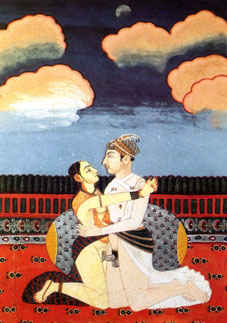 The name Kama Sutra stirs up images of the erotic Orient, of sexual adepts locked in x-rated, acrobatic embraces bodies arched in the bliss of sexual yoga. Or, less poetically, its that book with all the kinky sex positions. The fact that it is an ancient oriental book of kinky sex positions, only makes it that much more exotic and titillating. Considering its ancient beginnings (it was written in India between 100-500 A.D.), it is not surprising that this classic work of Hindu eroticism has fired the imaginations of countless generations of horny couples seeking new ways to do it. And, given this usage, its also not surprising that most folks prefer the Kama Sutras illustrated versions—with dewy eyed couples pretzeled together for ones viewing enjoyment.
The name Kama Sutra stirs up images of the erotic Orient, of sexual adepts locked in x-rated, acrobatic embraces bodies arched in the bliss of sexual yoga. Or, less poetically, its that book with all the kinky sex positions. The fact that it is an ancient oriental book of kinky sex positions, only makes it that much more exotic and titillating. Considering its ancient beginnings (it was written in India between 100-500 A.D.), it is not surprising that this classic work of Hindu eroticism has fired the imaginations of countless generations of horny couples seeking new ways to do it. And, given this usage, its also not surprising that most folks prefer the Kama Sutras illustrated versions—with dewy eyed couples pretzeled together for ones viewing enjoyment.
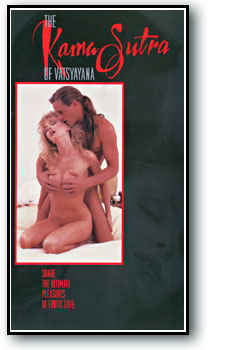 With its quest to classify every aspect of sexual life (including choosing a bride, flirting, satisfying your woman sexually, etc.), the Kama Sutra is really more of a self-help manual than a dirty book. Its just that most people seem to skip straight to the sex positions and go no further. With Beavis and Butthead sensibilities, they stickily finger its pages while gloating, Huh-huh, sex! Huh-huh, huh-huh. Wow those dudes are really getting it on. Of course, to be fair, most people probably feel a bit put off by the advice on buying a wife, sneaking into a harem, or being bathed by the public shampooer. At first glance, these passages seem anachronistic and irrelevant to say the least.
With its quest to classify every aspect of sexual life (including choosing a bride, flirting, satisfying your woman sexually, etc.), the Kama Sutra is really more of a self-help manual than a dirty book. Its just that most people seem to skip straight to the sex positions and go no further. With Beavis and Butthead sensibilities, they stickily finger its pages while gloating, Huh-huh, sex! Huh-huh, huh-huh. Wow those dudes are really getting it on. Of course, to be fair, most people probably feel a bit put off by the advice on buying a wife, sneaking into a harem, or being bathed by the public shampooer. At first glance, these passages seem anachronistic and irrelevant to say the least.
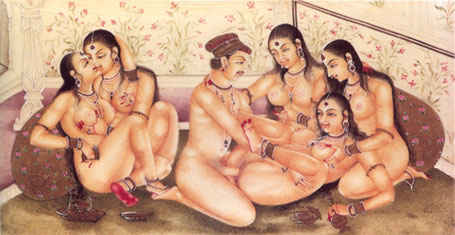 By contrast, Vatsyayana, the ancient author of the Kama Sutra, would have us slow down, redecorate our homes to please all of our senses (flowers, incense, beautiful art, soft fabrics and cushions, music, etc.), and invite our friends over for wine and jokes and warmth all while getting a little flirtation going on with the one we love.
By contrast, Vatsyayana, the ancient author of the Kama Sutra, would have us slow down, redecorate our homes to please all of our senses (flowers, incense, beautiful art, soft fabrics and cushions, music, etc.), and invite our friends over for wine and jokes and warmth all while getting a little flirtation going on with the one we love.
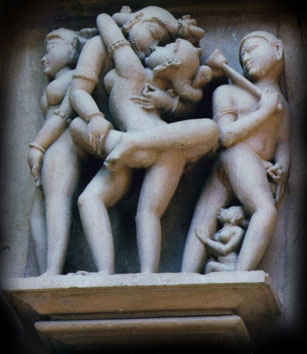 Her limbs, entwined in yours
Her limbs, entwined in yours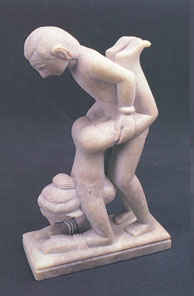 Seize her feet and lift them high
Seize her feet and lift them high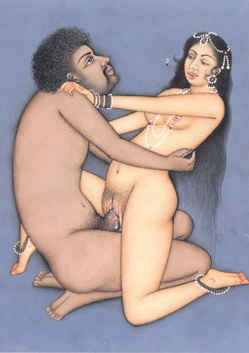 While Christian mythology teaches that the world was made by a God The Father who doesn't like people to have sex (except to procreate), Hindu mythology teaches that the souls of men and women could be elevated to a higher level of being through enlightened sexual activity. As the story goes, long, long ago the divine consciousness (the sentient cosmos, God, etc.) had split from a singularity, the One, into the Two. The resultant divine duo ultimately found their greatest fulfillment in acknowledging their intrinsic and underlying oneness and equality and in treating each other with love. In this state, they experienced greatest harmony and bliss.
While Christian mythology teaches that the world was made by a God The Father who doesn't like people to have sex (except to procreate), Hindu mythology teaches that the souls of men and women could be elevated to a higher level of being through enlightened sexual activity. As the story goes, long, long ago the divine consciousness (the sentient cosmos, God, etc.) had split from a singularity, the One, into the Two. The resultant divine duo ultimately found their greatest fulfillment in acknowledging their intrinsic and underlying oneness and equality and in treating each other with love. In this state, they experienced greatest harmony and bliss.
 Without this perspective we might be mystified, nay stupified, by his choice to devoting an entire chapter to classifying the basic sizes of penises and vaginas, in all their possible combinations. What once seemed eccentric and anal-retentive can now be seen as... Okay, so it still seems eccentric and anal-retentive. But it was not without higher purpose and intention.
Without this perspective we might be mystified, nay stupified, by his choice to devoting an entire chapter to classifying the basic sizes of penises and vaginas, in all their possible combinations. What once seemed eccentric and anal-retentive can now be seen as... Okay, so it still seems eccentric and anal-retentive. But it was not without higher purpose and intention.
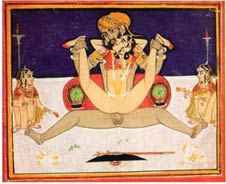 And of course the couple could make use of the various sex positions described in the Kama Sutra, with the elephant woman (a reference to her large vagina, not an encephalitic head)lying down in such a way as to contract her vagina. She was especially encouraged to assume the clasping position, the pressing position, the twining position, or the mare's position.
And of course the couple could make use of the various sex positions described in the Kama Sutra, with the elephant woman (a reference to her large vagina, not an encephalitic head)lying down in such a way as to contract her vagina. She was especially encouraged to assume the clasping position, the pressing position, the twining position, or the mare's position.
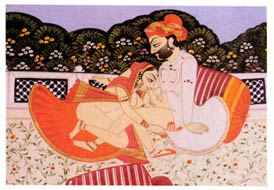 First rub your penis with wasp stings
First rub your penis with wasp stings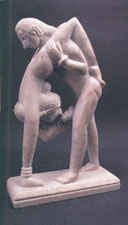
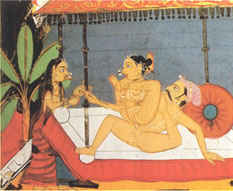
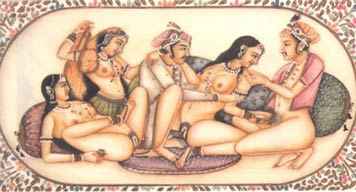 Which is more or less a way of saying that women take longer. For the average 18 year old male who wonders why he cant make his girlfriend cum before he shoots his two-minute load, the foregoing passage might just clarify a thing or two. As would this passage:
Which is more or less a way of saying that women take longer. For the average 18 year old male who wonders why he cant make his girlfriend cum before he shoots his two-minute load, the foregoing passage might just clarify a thing or two. As would this passage:
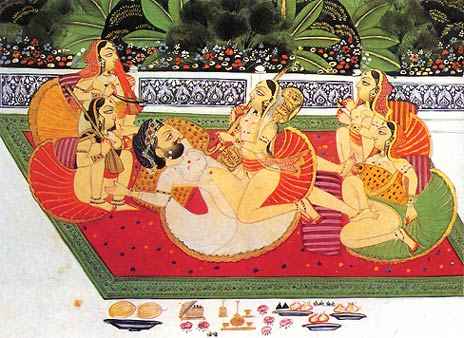 Shortly after, in 1883, Burtons Kama Shastra society, a kind of sexual anthropological club, published the Kama Sutra for private circulation. The book caused such a furor in sexually repressive Victorian England (imagine, depicting women enjoying sex the very idea!), that the book was banned and not published for public consumption again until 1963.
Shortly after, in 1883, Burtons Kama Shastra society, a kind of sexual anthropological club, published the Kama Sutra for private circulation. The book caused such a furor in sexually repressive Victorian England (imagine, depicting women enjoying sex the very idea!), that the book was banned and not published for public consumption again until 1963.